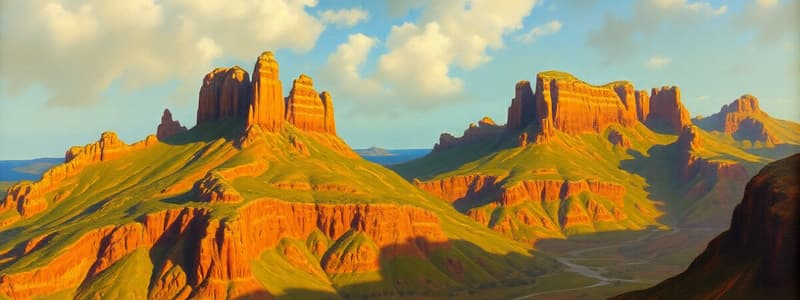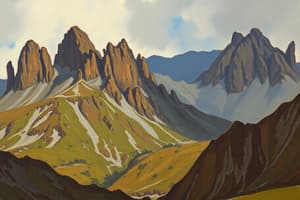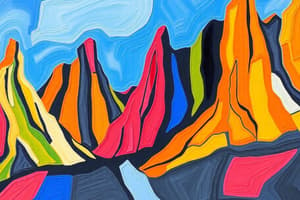Podcast
Questions and Answers
What natural process forms valleys between mountains or hills?
What natural process forms valleys between mountains or hills?
Erosion
How does the shape of valleys differ when formed by glaciers compared to rivers?
How does the shape of valleys differ when formed by glaciers compared to rivers?
Glacier-formed valleys are U-shaped, while river-formed valleys are V-shaped.
What are coastal plains and how are they formed?
What are coastal plains and how are they formed?
Coastal plains are lowlands next to seas or oceans, formed by the action of water.
Why are plains considered excellent agricultural ground?
Why are plains considered excellent agricultural ground?
Name one valley mentioned that is U-shaped and another that is V-shaped.
Name one valley mentioned that is U-shaped and another that is V-shaped.
Flashcards
What is a V-shaped valley?
What is a V-shaped valley?
A low-lying area of land between mountains or hills, formed by river erosion, with a characteristic V-shape.
What is a plain?
What is a plain?
A flat and broad landform with little change in elevation, often formed by water, ice, or magma. Provides fertile ground for agriculture.
What is erosion?
What is erosion?
The process of wearing down rocks and soil by natural forces like water, wind, or ice.
What are coastal plains?
What are coastal plains?
Signup and view all the flashcards
What are erosional plains?
What are erosional plains?
Signup and view all the flashcards
Study Notes
Valleys
- Valleys are low-lying landforms between hills or mountains.
- Valleys form due to erosion, the natural process of water wearing down rocks and soil.
- Water flowing down mountains carves V-shaped channels.
- Glaciers create U-shaped valleys.
- Valleys usually have pleasant climates, making them good places to live.
- Water from rivers in valleys provides resources for human settlements.
Plains
- Plains are broad, flat landforms with little elevation change.
- Plains are made by factors such as water, ice, and magma.
- Plains are excellent farmland because the soil is fertile.
- Plains near seas/oceans are called coastal plains.
- Plains made by rivers, wind and erosion are called erosional plains.
- Plains cover about a third of Earth's land area.
Plateaus
- The text refers to a plateau, the Lasithi plateau in Crete Island, Greece, as an example of flat land.
- The sides of plateaus in picture B are called cliffs.
Studying That Suits You
Use AI to generate personalized quizzes and flashcards to suit your learning preferences.
Description
Explore the unique characteristics and formation processes of valleys, plains, and plateaus. This quiz covers how these landforms are shaped by natural forces like erosion and sedimentation. Test your knowledge of their significance and benefits to human settlements.



